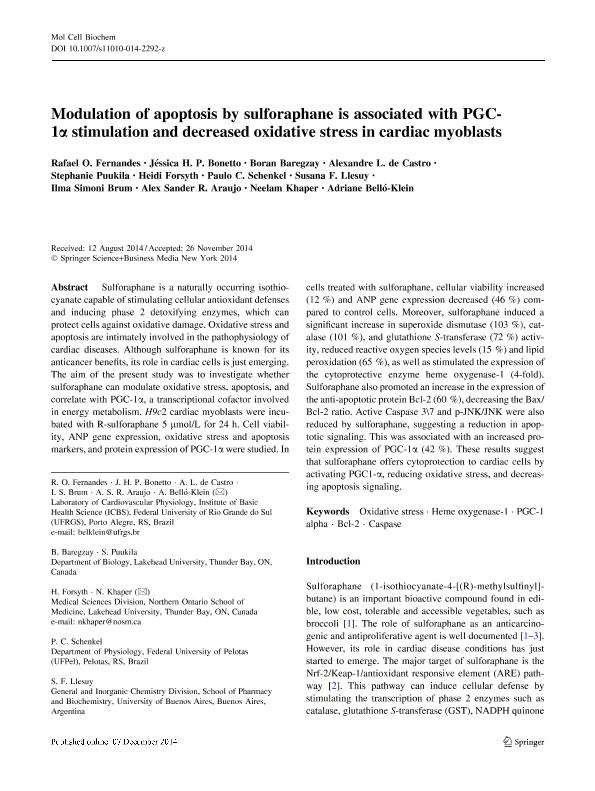Mostrar el registro sencillo del ítem
dc.contributor.author
Fernandes, Rafael O.
dc.contributor.author
Bonetto, Jéssica H. P.
dc.contributor.author
Baregzay, Boran
dc.contributor.author
de Castro, Alexandre L.
dc.contributor.author
Puukila, Stephanie
dc.contributor.author
Forsyth, Heidi
dc.contributor.author
Schenkel, Paulo C.
dc.contributor.author
Llesuy, Susana Francisca

dc.contributor.author
Brum, Ilma Simoni
dc.contributor.author
Araujo, Alex Sander R.
dc.contributor.author
Khaper, Neelam
dc.contributor.author
Belló Klein, Adriane
dc.date.available
2018-03-19T20:36:54Z
dc.date.issued
2015-03
dc.identifier.citation
Fernandes, Rafael O.; Bonetto, Jéssica H. P.; Baregzay, Boran; de Castro, Alexandre L.; Puukila, Stephanie; et al.; Modulation of apoptosis by sulforaphane is associated with PGC-1α stimulation and decreased oxidative stress in cardiac myoblasts; Springer; Molecular and Cellular Biochemistry; 401; 1-2; 3-2015; 61-70
dc.identifier.issn
0300-8177
dc.identifier.uri
http://hdl.handle.net/11336/39274
dc.description.abstract
Sulforaphane is a naturally occurring isothiocyanate capable of stimulating cellular antioxidant defenses and inducing phase 2 detoxifying enzymes, which can protect cells against oxidative damage. Oxidative stress and apoptosis are intimately involved in the pathophysiology of cardiac diseases. Although sulforaphane is known for its anticancer benefits, its role in cardiac cells is just emerging. The aim of the present study was to investigate whether sulforaphane can modulate oxidative stress, apoptosis, and correlate with PGC-1α, a transcriptional cofactor involved in energy metabolism. H9c2 cardiac myoblasts were incubated with R-sulforaphane 5 µmol/L for 24 h. Cell viability, ANP gene expression, oxidative stress and apoptosis markers, and protein expression of PGC-1α were studied. In cells treated with sulforaphane, cellular viability increased (12 %) and ANP gene expression decreased (46 %) compared to control cells. Moreover, sulforaphane induced a significant increase in superoxide dismutase (103 %), catalase (101 %), and glutathione S-transferase (72 %) activity, reduced reactive oxygen species levels (15 %) and lipid peroxidation (65 %), as well as stimulated the expression of the cytoprotective enzyme heme oxygenase-1 (4-fold). Sulforaphane also promoted an increase in the expression of the anti-apoptotic protein Bcl-2 (60 %), decreasing the Bax/Bcl-2 ratio. Active Caspase 3\7 and p-JNK/JNK were also reduced by sulforaphane, suggesting a reduction in apoptotic signaling. This was associated with an increased protein expression of PGC-1α (42 %). These results suggest that sulforaphane offers cytoprotection to cardiac cells by activating PGC1-α, reducing oxidative stress, and decreasing apoptosis signaling.
dc.format
application/pdf
dc.language.iso
eng
dc.publisher
Springer

dc.rights
info:eu-repo/semantics/openAccess
dc.rights.uri
https://creativecommons.org/licenses/by-nc-sa/2.5/ar/
dc.subject
Oxidative Stress
dc.subject
Heme Oxygenase-1
dc.subject
Pgc-1 Alpha
dc.subject
Bcl-2
dc.subject
Caspase
dc.subject.classification
Otras Ciencias Biológicas

dc.subject.classification
Ciencias Biológicas

dc.subject.classification
CIENCIAS NATURALES Y EXACTAS

dc.title
Modulation of apoptosis by sulforaphane is associated with PGC-1α stimulation and decreased oxidative stress in cardiac myoblasts
dc.type
info:eu-repo/semantics/article
dc.type
info:ar-repo/semantics/artículo
dc.type
info:eu-repo/semantics/publishedVersion
dc.date.updated
2018-03-13T13:55:20Z
dc.journal.volume
401
dc.journal.number
1-2
dc.journal.pagination
61-70
dc.journal.pais
Alemania

dc.journal.ciudad
Berlín
dc.description.fil
Fil: Fernandes, Rafael O.. Universidade Federal do Rio Grande do Sul; Brasil
dc.description.fil
Fil: Bonetto, Jéssica H. P.. Universidade Federal do Rio Grande do Sul; Brasil
dc.description.fil
Fil: Baregzay, Boran. Lakehead University; Canadá
dc.description.fil
Fil: de Castro, Alexandre L.. Universidade Federal do Rio Grande do Sul; Brasil
dc.description.fil
Fil: Puukila, Stephanie. Lakehead University; Canadá
dc.description.fil
Fil: Forsyth, Heidi. Lakehead University; Canadá
dc.description.fil
Fil: Schenkel, Paulo C.. Universidade Federal de Pelotas; Brasil
dc.description.fil
Fil: Llesuy, Susana Francisca. Universidad de Buenos Aires. Facultad de Farmacia y Bioquímica. Departamento de Química Analítica y Fisicoquímica. Cátedra de Química General e Inorgánica; Argentina. Consejo Nacional de Investigaciones Científicas y Técnicas. Oficina de Coordinación Administrativa Houssay. Instituto de Bioquímica y Medicina Molecular. Universidad de Buenos Aires. Facultad de Farmacia y Bioquímica. Instituto de Bioquímica y Medicina Molecular; Argentina
dc.description.fil
Fil: Brum, Ilma Simoni. Universidade Federal do Rio Grande do Sul; Brasil
dc.description.fil
Fil: Araujo, Alex Sander R.. Universidade Federal do Rio Grande do Sul; Brasil
dc.description.fil
Fil: Khaper, Neelam. Lakehead University; Canadá
dc.description.fil
Fil: Belló Klein, Adriane. Universidade Federal do Rio Grande do Sul; Brasil
dc.journal.title
Molecular and Cellular Biochemistry

dc.relation.alternativeid
info:eu-repo/semantics/altIdentifier/doi/http://dx.doi.org/ 10.1007/s11010-014-2292-z
dc.relation.alternativeid
info:eu-repo/semantics/altIdentifier/url/https://link.springer.com/article/10.1007%2Fs11010-014-2292-z
Archivos asociados
